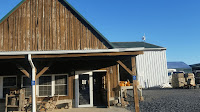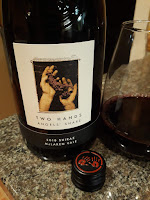October was
Virginia Wine Month and we were able to visit a few wineries while traveling along U.S. Route 29 to and from Winston-Salem, North Carolina. Known as the Seminole Trail or "29th Infantry Division Memorial Highway", this well-traveled road runs from the Tarheel state through Virginia and intersects several popular wine regions within the Commonwealth. These wine trails include the
Fauquier County Wine Trail,
Monticello Wine Trail,
Jefferson Heritage Trail, and
SoVA Wine Trail.
theCompass Craft Beverage Finder can guide you to these destinations with the wineries we visited listed south to north.
 Lazy Days Winery
Lazy Days Winery
This winery is located in Amherst County right off the highway and resides just a few miles south of Rebec offers ten wines all from 100% estate grapes. Starting with dry wines, the
Chardonnay Reserve 2014 ($20) is just slightly oaked -- providing light butter and texture and a bottle came home. I also purchased the friendly
Sweet Lazy Red ($20), a well made off-dry wine that is a blend of Chambourcin and Petit Manseng. It's sibling, the
Sweet Lazy White ($18) is a festival favorite being 2.5% r.s. but plenty of acidity from the majority Petit Manseng and Vidal Blanc grapes. And for dry reds, try the
2013 Petit Verdot ($22).
Rebec Vineyards
This winery resides just a few miles north of Lazy Days and for history enthusiasts, the family home, Mountainview, is listed on both the National Register of Historic Places and as a Virginia Landmark. Winemaker Svetlozar Kanev is a native Bulgarian and his signature wine is the
Sweet Sofia ($19) - an herb-infused based on a Bulgarian recipe. Its worth bring a bottle home to experiment with various food or situational pairings. The remaining portfolio is quite extensive encompassing dry to sweet wines using grapes and other fruit. The dry reds are well made and tasty - particularly the
Pinot Noir ($26),
Cabernet Franc ($24), and
Landmark Reserve Sangiovese ($30). Other visitors raved about the semi-dry
Riesling ($20) but I preferred the
Gewurtztraminer ($23),
Chardonnay ($20), and
Viognier ($20). These three were very representative of the specific grape varieties and, with the Sweet Sofia, are resting in our cellar.
Brent Manor Vineyards
This is a relatively new winery situated south of Charlottesville and north of Lovingston -- right off the highway in Faber. The winery reflects the Portuguese heritage of owner Jorge Raposo. They even offer several Portuguese wines for sale but for our purposes, we are covering their Virginia made wines. These wines are made from a combination of French hybrid and vinifera grapes and take my word - do not discount the hybrids. The
2017 Brent Manor Vidal Blanc ($17) is full of grapefruit and melon flavors plus refreshing acids - a solid wine. Similarly, the
2016 Chambourcin Reserve ($29) is full-bodied, with slight spice and leather and the reason for our visit. The representative from Lazy Days had mentioned that it was the best Chambourcin in the Commonwealth and he may be correct. Another solid and refreshing wine is their
2015 Rosado Virginia Rose Wine ($19) - a blend of Cabernet Franc, Chambourcin, and Viognier. More raspberry than strawberry for this one. In order to stay true to Portugal, Brent Manor produces a couple Port styled wines and take a look at the
2018 Vihno Abafado Branco ($29) made from a Petit Manseng base and fortified with neutral grape spirits. The nuts, vanilla, and acidity kill it.
 Montifalco Vineyard
Montifalco Vineyard
Since we were traveling North, Raposo suggested this new endeavor located in Advance Mills, just off Route 29 between Ruckersville and the Charlottesville Airport. The winery's name Montifalco is a play on the Monticello AVA and owner Justin Falco's family name. The estate vineyard is planted with an interesting mix of Semillon, Sauvignon Blanc, Rkatsiteli, and Saperavi - the latter two originating from cuttings from
Dr. Konstantin Frank Vinifera Wine Cellars and perhaps available next year. At the top of the tasting sheet is the white Bordeaux
2018 Montifalco Blanc ($22) and the
2017 Montifalco Barrel Reserve Chardonnay ($25). Both are excellent wines, spot on and flavor profiles and I couldn't leave without a bottle of each. The
2018 Montifalco Cabernet Franc ($23) and
2016 Montifalco Meritage ($35) were also solid wines particularly for the Cabernet Franc considering rain-soaked 2018 was a horrible grape season. Thus, this is a lighter-bodied wine but with enough cherries and acidity to make it interesting. In contrast, the Meritage -- made from all five Bordeaux red grapes -- is full-bodied, juicy, textured, a little dirty, with firm grippy tannins.
 Swover Creek Farms and Kitchen - Edinburg
Swover Creek Farms and Kitchen - Edinburg
 Wolf Gap Vineyard - Edinburg
Wolf Gap Vineyard - Edinburg

















































